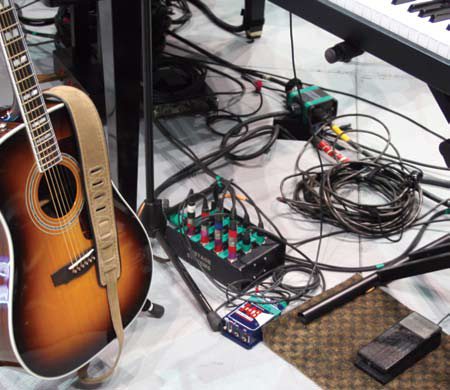
Passive Versus Active
Transformers do not require any form of power to make them work. They are passive. Mic bridging (or splitter) transformers are available with 1, 2 or even 3 isolated outputs.
The more splits, the more expensive. This sometimes leads to companies opting for active splitters, which employ preamp circuits (like the ones in your mixer) to buffer the microphone signals. When an active splitter is employed, the preamp essentially moves from the mixer into the snake.
This also applies to digital snakes. In other words, the sound of your expensive mixer has now been replaced by low-cost ICs. Transformers and active buffers react very differently when they’re overloaded. When active circuits are hit hard, they distort causing a very harsh sounding square wave (clipped output).
When transformers are hit hard, they saturate. Good ones such as those made by Jensen round out the sound in a more gradual way, rendering a warmer tone.
A point of contention with digital snakes is “who” is in control. With a passive snake, each mixing desk is directly coupled to the electrical output from microphone. Many system techs prefer passive snakes because it allows each engineer to set the mic levels based on their needs.
For instance. when controlling levels for in-ear monitors, having the house engineer turn up the trim level without notice can cause serious ear damage to the artist on stage. (And sometimes the monitor engineer’s job.)
And although one cannot deny the appeal of deploying a single fiber versus and a big fat snake cable, when a snake cable fails it is usually only one channel that goes down, not the catastrophic problem of a complete system failure.
Analog snakes can be repaired with a soldering iron while digital alternatives require the band to carry a spare and extra logistical planning to return the down unit to the factory. For many, field serviceability is a primary concern.
It’s important to note that most signals traveling around a stage are mic level, including the output from the many direct boxes that are used to feed bass, acoustics and keyboards to the PA system. By ensuring all levels are the same, should a channel fail, it is simply a matter of re-patching to a spare. This “standard” practice makes it easy and quick to resolve issues, especially when 20,000 fans are waiting to be entertained.
Modular Versus Flat Panel
For decades, snake manufacturers have been producing flat-panel snakes that mount all of the XLR connectors on the front panel with multi-pins below. This is the most economical method of producing a snake.
More recently, there has been a shift towards modular designs that enable the user to reconfigure the system to adapt for future needs. The benefits with modular designs include being able to add extras such as sub-snakes, cross-patching capabilities, or extra outputs for broadcast and recording feeds.
Being able to quickly replace an input strip should field service be required is an added benefit. The down-side is a higher cost at the outset due to added metal work and electronics employed to produce the frame and individual channel strips.
When on tour, 99 percent of all problems can usually be traced to cold solder joints, faulty wiring or second rate connectivity due to bad cables. Truck vibrations are particularly hard on equipment. And the biggest monster of all is the snake system. If your interconnect system fails, you’re late for dinner or worse, you may lose the gig.
The snake system is the umbilical cord that brings it all together and should not be skimped on.
Peter Janis is president of Radial Engineering and has worked in professional audio for more than 30 years.

